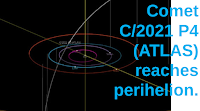The Perseid Meteor Shower lasts from late July to early September each year, and are expected to be at a peak before dawn on Saturday 13 August 2022. Viewing will be poor for the Perseids this year, as the meteors peak slightly after the Full Moon on Friday 12 August. The Perseids get their name from the constellation of Perseus, in which the meteors have their radiant (the point from which they appear to originate).
Meteor showers are thought to be largely composed of material from the tails of comets. Comets are composed largely of ice (mostly water and carbon dioxide), and when they fall into the inner Solar System the outer layers of this boil away, forming a visible tail (which always points away from the Sun, not in the direction the comet is coming from, as our Earth-bound experience would lead us to expect). Particles of rock and dust from within the comet are freed by this melting (strictly sublimation, transforming directly from a solid to a gas due to the low pressure on it's surface) of the comet into the tail and continue to orbit in the same path as the comet, falling behind over time.
Comet 109P/Swift-Tuttle was discovered independently in July 1862 by the astronomers Lewis Swift and Horace Parnell Tuttle, after whom it is named. The number 109P implies that it was the 109th comet discovered (strictly speaking people had been observing comets for thousands of years, but it was not until the mid-eighteenth century that it was realised that they were predictable objects that returned cyclically), that it is a periodic comet (P - again, most comets are periodic, but the term 'periodic comet' is reserved for those with periods of less than 200 years, since these can be reliably predicted).
Comet 109P/Swift-Tuttle itself only visits the Inner Solar System once every 133 years, last doing so in 1992, on an eccentric orbit tilted at 113° to the plane of the Solar System (or 67° with a retrograde orbit - an orbit in the opposite direction to the planets - depending on how you look at it), that takes it from 0.95 AU from the Sun (95% of the distance at which the Earth orbits the Sun) to 51.22 AU from the Sun (51.22 times as far from the Sun as the Earth, more than three times as far from the Sun as Neptune and slightly outside the Kuiper Belt, but only scraping the innermost zone of the Oort Cloud). The comet is next expected to visit the Inner Solar System in 2126, reaching about 22 950 00 km (0.15 AU) from Earth in August of that year. As a comet with a period of more than 20 years but less than 200 years, 109P/Swift-Tuttle is considered to be a Periodic Comet, and a Halley-type Comet.
See also...
Follow Sciency Thoughts on Facebook.
Follow Sciency Thoughts on Twitter.





.jpg)





